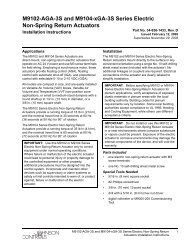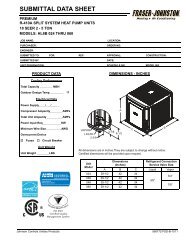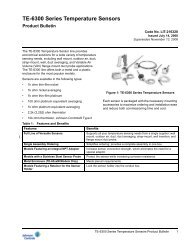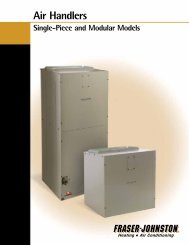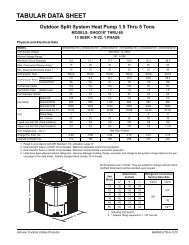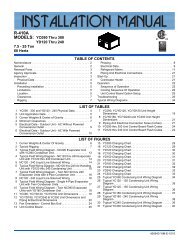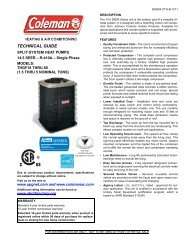USER'S, MAINTENANCE and SERVICE ... - Upgnet.com
USER'S, MAINTENANCE and SERVICE ... - Upgnet.com
USER'S, MAINTENANCE and SERVICE ... - Upgnet.com
You also want an ePaper? Increase the reach of your titles
YUMPU automatically turns print PDFs into web optimized ePapers that Google loves.
®CONTENTSSAFETY INFORMATION . . . . . . . . . . . . . . . . 2FOR YOUR SAFETY . . . . . . . . . . . . . . . . . . . . . . . 2SYSTEM OPERATION . . . . . . . . . . . . . . . . . . 2THERMOSTATS . . . . . . . . . . . . . . . . . . . . . . . . . . 2INTERMITTENT IGNITION DEVICE . . . . . . . . . . . 2INPUT . . . . . . . . . . . . . . . . . . . . . . . . . . . . . . . . . . 3OPERATING INSTRUCTIONS . . . . . . . . . . . . . . . 3TO SHUT DOWN THE FURNACE: . . . . . . . . . . . 3TO LIGHT THE FURNACE: . . . . . . . . . . . . . . . . . 3VENT SAFETY SYSTEM: . . . . . . . . . . . . . . . . . . 3100% SHUT OFF: . . . . . . . . . . . . . . . . . . . . . . . . 3EXPLAIN UNIT FUNCTION . . . . . . . . . . . . . . 4GENERAL <strong>MAINTENANCE</strong> . . . . . . . . . . . . . . 4HEATING SYSTEM INSPECTION . . . . . . . . . . . . 4BURNER AND PILOT CHECK . . . . . . . . . . . . . . . 4CLEANING BURNERS . . . . . . . . . . . . . . . . . . . . . 5CLEANING FLUE PASSAGES ANDHEATING ELEMENTS . . . . . . . . . . . . . . . . . . . . 5AIR FILTERS . . . . . . . . . . . . . . . . . . . . . . . . . . . . . 5ECONOMIZER . . . . . . . . . . . . . . . . . . . . . . . . . . . . 6BLOWER ASSEMBLY . . . . . . . . . . . . . . . . . . . . . . 6BLOWER SHAFT BEARING 6MOTORS . . . . . . . . . . . . . . . . . . . . . . . . . . . . . . . . 6CONDENSER COIL . . . . . . . . . . . . . . . . . . . . . . . . 7REGISTERS . . . . . . . . . . . . . . . . . . . . . . . . . . . . . 7TROUBLESHOOTING . . . . . . . . . . . . . . . . . . 7BEFORE CALLING A <strong>SERVICE</strong> PERSON: . . . . . 7USER’S, <strong>MAINTENANCE</strong> <strong>and</strong><strong>SERVICE</strong> INFORMATIONMANUALSINGLE PACKAGEAIR CONDITIONERGAS/ELECTRICThe manufacturer re<strong>com</strong>mends that the “User” read all sections of this manual <strong>and</strong>keep the manual for future reference.FIRE OR EXPLOSION HAZARDFailure to follow safety warnings exactly couldresult in serious injury, death, or property damage.- Do not store or use gasoline or other flammablevapors <strong>and</strong> liquids in the vicinity of this orany other appliance.- WHAT TO DO IF YOU SMELL GAS:•Do not try to light any appliance.•Do not touch any electrical switch; do not use anyphone in your building.•Leave the building immediately.•Immediately call your gas supplier from a neighbor’sphone. Follow the gas supplier’s instructions.•If you cannot reach your gas supplier, call the firedepartment.- Installation <strong>and</strong> service must be performed bya qualified installer, service agency or the gassupplier.66441-YUM-C-0711
66441-YUM-C-0711SAFETY INFORMATIONFOR YOUR SAFETY• Make sure that the furnace area is clear <strong>and</strong> free of <strong>com</strong>bustiblematerials, gasoline <strong>and</strong> other flammable vapors<strong>and</strong> liquids.• Be sure the furnace is free <strong>and</strong> clear of insulating material.Examine the furnace area after installation of the furnaceor the installation of additional insulation. Sometypes of insulation are <strong>com</strong>bustible.• For proper operation of this furnace, air for <strong>com</strong>bustion<strong>and</strong> ventilation is required. Make sure that these openingsare not obstructed.• For lighting or shutting down this furnace, refer to thelighting instructions provided adjacent to the burners <strong>and</strong>also located in this manual.• A blocked vent roll-out switch is provided in the burner<strong>com</strong>partment. This switch is a manual reset. If the furnacefails to operate, contact a qualified service technician.SYSTEM OPERATIONTHERMOSTATSSet your thermostat for either heating or cooling then set it forthe desired temperature. DO NOT MOVE THE THERMO-STAT RAPIDLY ON AND OFF, OR BACK AND FORTHFROM HEAT TO COOL. THIS COULD DAMAGE YOUREQUIPMENT.Always allow at least 5 minutes between changes. Find thetemperature that is most <strong>com</strong>fortable to you, <strong>and</strong> then LEAVEYOUR THERMOSTAT ALONE. (Exception is for night orvacation “set back” to conserve energy).Manually moving the thermostat up or down will not speed uptemperature changes in your rooms. This only causes thethermostat switch to function at your <strong>com</strong>m<strong>and</strong> rather thanresponding to room temperature.Heat generated by devices other than the furnace may interferewith thermostat performance. Therefore, lamps, radios,television sets, etc. should not be placed near the thermostat.• Should the gas supply fail to shut off or if overheatingoccurs, shut off the gas valve to the furnace before shuttingoff the electrical supply. Then call a qualified servicetechnician.• Do not use this furnace if any part has been under water.A flood-damaged furnace is extremely dangerous.Attempts to use the furnace can result in fire or explosion.A qualified service technician should be contactedto inspect the furnace <strong>and</strong> to replace all gas controls,control system parts, electrical parts that have been wetor the furnace if deemed necessary.• Determine the integrity of the installation regarding theflue gas vent, the return <strong>and</strong> supply air duct. Confirm theequipment is well supported <strong>and</strong> there are no signs ofdeterioration. The manufacturer re<strong>com</strong>mends that mainburner, ignition device <strong>and</strong> controls are inspected by aqualified service technician before each heating season.FIGURE 1 - TYPICAL THERMOSTATINTERMITTENT IGNITION DEVICEYour unit is equipped with a cycling pilot burner. It has a PilotRelight control designed to automatically light the pilot burnereach time the thermostat “calls” for heat.This furnace is equipped with an intermittent pilot <strong>and</strong> automaticre-ignition system. Do Not attempt to manually relightthe pilot. Personal injury could result.2 Johnson Controls Unitary Products
66441-YUM-C-0711When the thermostat calls for heat, pilot gas is supplied <strong>and</strong>at the same time, sparking occurs to light the pilot gas. Withthe pilot lit, the flame sensor rod closes a circuit to the ignitorcontrol which then opens the gas valve to admit main burnergas.When the room thermostat is satisfied, the electrical circuit tothe gas valve is opened, closing off both main burner <strong>and</strong>pilot gas simultaneously. If the pilot burner should fail to light,contact your heating contractor or gas utility for service toinsure that proper operating conditions are restored.INPUTThe correct heat capacity of the furnace is regulated by theburner orifices <strong>and</strong> the gas pressure. The proper orifices arefurnished but the gas pressure regulator must be adjusted bythe installer or gas utility service technician.OPERATING INSTRUCTIONSTO SHUT DOWN THE FURNACE:1. Close the main gas shutoff valve(s).2. Turn off the electric power supply.TO LIGHT THE FURNACE:1. Do not attempt to light manually.2. Open the main gas shutoff valve(s).3. Adjust the set point of the room thermostat above the temperaturein the space.4. Turn on the electric power supply.5. The draft fan will operate. After an adequate purge time,the electric spark igniter will light the burners.6. The burners will extinguish <strong>and</strong> relight automatically uponthe dem<strong>and</strong> of the room thermostat.VENT SAFETY SYSTEM:This gas furnace is equipped with an automatic reset hightemperature sensor or rollout switch which in the unlikelyevent of a sustained main burner flame rollout will shut off theflow of gas by closing the main gas valve. The ignition moduleswill also be disabled, preventing the flow of gas to thevalves. The switch is located inside the gas heat accesspanel above the burner inlet. Flame rollout can be caused byblockage of the power vent system, improper gas pressure oradjustment. If this event occurs the furnace will not operateproperly, gas supply to the furnace should be shut off <strong>and</strong> noattempt should be made to place the furnace in operation.The system should be inspected by a qualified service technician.Refer to Figure 2 for a typical installation.100% SHUT OFF:The ignition modules are designed for 100% shut-off. If thefurnace fails to ignite within 85 seconds after a call for heat,the flow of gas (including pilot) will be shut off <strong>and</strong> the ignitionmodule will lock out. The module can be reset by:A. Turning the system switch on the room thermostat to the“OFF” position <strong>and</strong> back to the “HEAT” position.B. Decreasing the set point of the room thermostat belowthe temperature in the conditioned space <strong>and</strong> returning itto its original setting.C. Opening <strong>and</strong> closing the unit's main disconnect switch.FIGURE 2 - TYPICAL INSTALLATIONJohnson Controls Unitary Products 3
66441-YUM-C-0711If the furnace continues to lock out, a qualified service technicianshould be called to determine the cause of the problem.ELECTRICAL SHOCK, FIRE OR EXPLOSION HAZARDFailure to follow safety warnings exactly could result in dangerousoperation, serious injury, death or property damage.Improper servicing could result in dangerous operation,serious injury, death or property damage.• Before servicing, disconnect all electrical power to furnace.• When servicing controls, label all wires prior to disconnecting.Reconnect wires correctly.• Verify proper operation after servicing.Prior to any of the following maintenance procedures, shutoff all power to the unit, to avoid personal injury.EXPLAIN UNIT FUNCTIONWhen the system is functioning properly, show the owner thelocation of all disconnect switches <strong>and</strong> the thermostat.Explain how to start <strong>and</strong> stop the unit <strong>and</strong> how to adjust temperaturesettings within the limitations of the system. Advisethat the flue exhaust hood surface <strong>and</strong> the immediate areawill experience high temperatures during the heating cycle,<strong>and</strong> that all unauthorized personnel <strong>and</strong> debris must be keptaway from this area.Snow or debris should not be allowed to accumulate in oraround the unit. Do not permit overhanging structures orshrubs to obstruct outdoor air discharge, <strong>com</strong>bustion airinlets or vent outlets on your unit. These provide air for <strong>com</strong>bustion<strong>and</strong> ventilation. Adequate air is important to the safe<strong>and</strong> proper operation of the unit.HEATING SYSTEM INSPECTIONIt is the owner's responsibility to insure that an annual inspectionof the entire heating portion of the unit is made by a qualifiedservice technician. This should include inspection of theburner, heating element <strong>and</strong> flue for any corrosion or sootaccumulation which may require cleaning <strong>and</strong> also checkingof burner <strong>and</strong> controls for proper operation.In addition, at least once during the heating season, theowner shall make a visual inspection of the flue outlet for evidenceof black soot or blockage of flue outlet by leaves orother debris. If any soot is found, it is re<strong>com</strong>mended a qualifiedservice technician be called immediately. If any blockageis found, it must be cleared immediately.Check for obvious signs of deterioration of the unit. Checkthat the return <strong>and</strong> supply ducts attached to the unit aresound <strong>and</strong> air tight. Check that the unit's physical support,concrete slab or roof curb, is sound <strong>and</strong> not in need of repair.Make sure there are no gaps between the roof curb <strong>and</strong> theunit where rain could leak into the building.Start the furnace. The vent motor should start, the igniter willstart to spark <strong>and</strong> ignite the pilot flame. After a short delay themain burner should ignite. If it does not, contact a qualified servicetechnician for assistance. Check the appearance of themain burner flame. Adjust burner shutters so no yellow flame isobserved in the heat exchanger tubes. (See Figure 3.) If flameadjustment cannot be made, obtain the assistance of a qualifiedservice technician <strong>and</strong> refer to the PILOT CHECKOUT<strong>and</strong> BURNER AIR SHUTTER ADJUSTMENT sections in theUNIT INSTALLATION INSTRUCTION.GENERAL <strong>MAINTENANCE</strong>In order to insure long <strong>and</strong> trouble free service from your system,we re<strong>com</strong>mend periodic inspection, cleaning, lubrication<strong>and</strong> adjustment by your installing Dealer/Contractor. Be sureto ask about this service. For those who prefer to do-it-yourself,please follow the instructions listed below to care foryour system.FIGURE 3 - TYPICAL FLAME APPEARANCEBURNER AND PILOT CHECKPeriodically (at least annually at the beginning of each heatingseason) make a visual check of the pilot <strong>and</strong> main burnerflame. If necessary, adjust main burner primary air shutters togive a distinct, sharp blue flame as explained under BURNERAIR SHUTTER ADJUSTMENT. If it is not possible to adjustfor the proper flame, the burners may need cleaning.4 Johnson Controls Unitary Products
66441-YUM-C-0711CLEANING BURNERSRemove them from the furnace as explained in BURNERINSTRUCTIONS section in the Unit Installation Instructions.Clean burners with wire brush <strong>and</strong> vacuum as needed.CLEANING FLUE PASSAGES ANDHEATING ELEMENTSWith proper <strong>com</strong>bustion adjustment, the heating element of agas fired furnace will seldom need cleaning. If the elementshould be<strong>com</strong>e sooted, it can be cleaned as follows:1. Remove the burner assembly as outlined in “BURNERINSTRUCTIONS” of the unit installation instructions.2. Remove the unit roof from over the gas heat section.12. When replacing the center <strong>and</strong> top of the flue collector box,be careful not to tear the adjoining insulation.13. Ensure that all seams on the vent side of the <strong>com</strong>bustionsystem are air tight. Apply a high temperature (+500°F)sealing <strong>com</strong>pound where needed.3. Remove the top plate <strong>and</strong> the top draft blower wheel fromthe upper draft blower housing.4. Remove the screws holding the top of the flue collectorbox. Carefully remove the top of the flue collector box withoutripping the adjacent insulation. Then remove the centerdivider plate separating the upper <strong>and</strong> lower flue boxes.5. On the inside of the flue collector box, remove the flue bafflesfrom the tube interiors. Note the last bend of the bafflefits tightly against the tube forcing the end of the baffle tolock into the tube collar. This collar is formed when the tubeis exp<strong>and</strong>ed into the end sheet. To remove, move the endof the baffle toward the center of the tube releasing the endof the baffle from the tube collar, then pull straight out of thetube. Refer to Figure 4.6. Using a wire brush on a flexible w<strong>and</strong>, brush out the insideof each heat exchanger from the burner inlet <strong>and</strong> flue outletends.7. Brush out the inside of the flue collector box <strong>and</strong> the fluebaffles.8. Run the wire brush down the vent hoods from the flue collectorend.9. If soot build-up is particularly bad, remove the vent motor<strong>and</strong> clean the wheel <strong>and</strong> housings. Run the wire brushdown the flue extensions at the outlet of the vent housings.10. After brushing is <strong>com</strong>plete, blow all brushed areas with airor nitrogen. Vacuum as needed.11. Replace parts in the order they were removed in Steps 1thru 5.FIGURE 4 - TYPICAL FLUE BAFFLE INSTALLATIONAIR FILTERSAll units contain 2" filters. Filters can be installed in the buildingat a suitable return air location if an economizer or outsideair accessory is not used. Filters must always be used. Theyshould be inspected once a month <strong>and</strong> thoroughly cleaned orreplaced if it appears they are beginning to accumulateexcessive dirt. Filter sizes <strong>and</strong> quantities are shown in the followingtable.THROWAWAYFILTERSIZES(Inches)15 TONSTD& HIGHEFF.QUANTITY PER UNIT (Nom, Tons)15, 20, 25TON REHEAT20 TONSTD & HIGHEFF.25 TONSTDEFF.15 - 25TONULTRAHIGHEFF.12 x 24 - - 12 1216x 20 - 4 - -16 x 25 - 4 - -18 x 24 5 - - -To install the filters, remove the filter access panel located tothe left of the condensate drain connection as shown in Figure5.NOTE: Filters must be installed with “Air Flow” arrows pointinginward -- toward the indoor coil. In the event thespacers in the filter section are removed, they mustbe reinstalled in their original position.Slide filters all the way into the filter racks provided. Whenmore than one filter in a filter rack is required, they must butteach other when sliding into position. Replace the filteraccess panel.Johnson Controls Unitary Products 5
66441-YUM-C-071115 TON(2) 18" X 24"FILTERS20 TON15,20,25 TON REHEAT(4) 16" X 20"FILTERS15 TON(3) 18" X 24"FILTERS20 TON15,20,25 TON REHEAT(4) 16" X 25"FILTERS(6) 12" X 24"FILTERS(6) 12" X 24"FILTERSINDOOR COILCONDENSATEDRAINCONNECTION15, 20, 25 TON REHEAT UNITS15 & 20 TON STANDARD & HIGH EFFICIENCY UNITSINDOOR COILCONDENSATEDRAINCONNECTIONExcessive lubrication may accelerate the accumulationof dust.BLOWER ASSEMBLYEven with good filters properly in place, blower wheels <strong>and</strong>motors will be<strong>com</strong>e dust laden after many months of operation.The entire blower assembly should be inspected annually.If the motor <strong>and</strong> wheel are heavily coated with dust, theycan be brushed <strong>and</strong> cleaned with a vacuum cleaner.BLOWER SHAFT BEARINGBlower shaft bearings should be inspected on a monthlybasis. At a minimum, the bearings should be relubricatedevery 6 months using a lithium-based grease (NLGI grade 2)re<strong>com</strong>mended for ball bearing service.25 TON STANDARD EFFICIENCY15, 17.5, 20, 25 TON ULTRA-HIGH EFFICIENCY UNITSFIGURE 5 - END VIEW LESS FILTER ACCESSPANELPerform all maintenance operations on the blowermotor with electric power disconnected from theunit. Do not attempt to lubricate bearings with theunit in operation.ECONOMIZEREven with good filters properly in place, the economizerassembly will be<strong>com</strong>e dust laden after many months of use.The entire assembly should be inspected annually. If theassembly is heavily coated with dust, it can be brushed <strong>and</strong>cleaned with a vacuum. A <strong>com</strong>mon aerosol contact cleanerwill help remove excess accumulation.After the dust <strong>and</strong> debris is removed, a silicon based spraylubricant should be applied to each of the gears used to connect<strong>and</strong> ensure proper alignment of the damper blades.Perform all maintenance operations on thedamper assembly with power disconnected. Donot clean or lubricate with the unit in operation.Damage can occur if the bearings are overlubricated.Use grease sparingly.MOTORSOutdoor fan motors are permanently lubricated <strong>and</strong> requireno maintenance.Ventor motor is factory lubricated for an estimated 10 yearlife.Indoor Blower Motor <strong>and</strong> Drive - The indoor blower motor featuresball bearings that do not require periodic lubrication.Periodic lubrication of the motor <strong>and</strong> bearings can extend thelife of <strong>com</strong>ponents but is optional.If desired, every three years, using a low pressure greasegun, pump grease into the bearing grease fitting until greasejust begins to show at the seals. Do not over lubricate. Useany lithium base grease re<strong>com</strong>mended for ball bearing service.6 Johnson Controls Unitary Products
66441-YUM-C-0711CONDENSER COILAn annual check <strong>and</strong> cleaning, if necessary, of the outdoorcoil should be done. Cleaning should be as often as necessaryto keep the coil clean. Clean any debris <strong>and</strong> dirt from theoutside coil face with a brush being careful not to damage thefins. If extremely dirty, a hose can be used to wash the coilfrom the inside out while brushing a soapy solution on theoutside.REGISTERSSupply <strong>and</strong> return air registers must be open when the unit isin operation. Obstructions must not be allowed to block airflowin or out of the registers.TROUBLESHOOTINGBEFORE CALLING A <strong>SERVICE</strong> PERSON:A. Check thermostat setting <strong>and</strong> insure thermostat is callingfor heat or cooling.B. Check thermostat for lint, etc.C. Check fuses or circuit breakers.D. Check filters for excessive dust accumulation.Johnson Controls Unitary Products 7
Subject to change without notice. Printed in U.S.A. 66441-YUM-C-0711Copyright © 2011 by Johnson Controls, Inc. All rights reserved.Supersedes: 66441/035-19699-001-B-0804Johnson Controls Unitary Products5005 York DriveNorman, OK 73069



